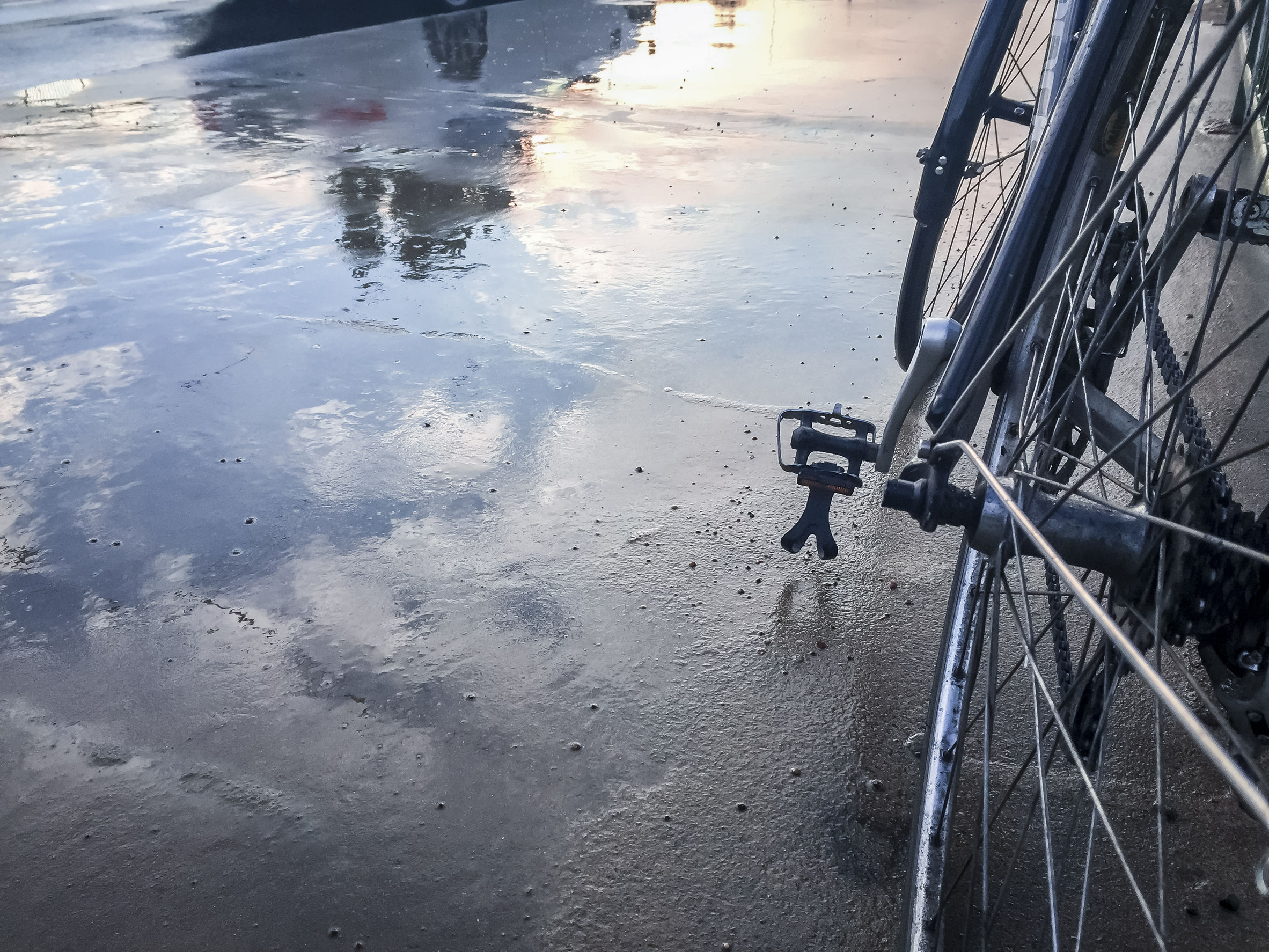Margot McGovern has handy hints to get you and your bike rain ready.
It’s rare to hear a fellow rider extol the joys of riding through a deluge. Indeed, most of us have woken up to the sound of rain rat-a-tat-tatting on the roof and been sorely tempted to leave the bike at home and take the train. However, with the right gear and a little forward planning, it’s possible to pedal in relative comfort through all but the worst downpour.
Be prepared
The trick to wet weather riding is not to get caught unawares. Smart riders (and let’s face it, weather nerds) always check the radar before they head out, even when rain seems unlikely, and plan accordingly. When poor weather is predicted, delay your ride until the worst of the storm has passed. If the weather is really ghastly, like during the Sydney storms earlier this year, leave the bike at home. Riding in extreme weather is not only unpleasant, it puts you at unnecessary risk.
For days when you are heading out in the rain, there’s a number of things you can do to make sure you and your bike are ready to roll with the weather.
If you do nothing else, keep a spare pair of socks and underwear at the office in case of emergencies. Better still, keep a full change of clothes/cycling kit at work for days when the weather catches you unawares or your riding clothes are still damp come home time.
Before the weather gets really mucky, set aside an hour or two one weekend to give your bike a thorough going over. First, give you bike a good clean. If you’re not sure how to spruce up your ride, follow Ride On’s step-by-step guide. When you’re done, give your frame a rub down with a degreaser, such as WD40, being careful to avoid the drivetrain and braking surfaces. This will help prevent mud and muck sticking to your bike.
It’s also worth paying special attention to your drive train, as grit accumulating in your chain and sprockets will make parts wear out faster and may result in costly replacements. We have a separate, step-by-step guide for this part of the cleaning process.
Next check your brakes are in good working order. If your brake pads are starting to wear thin, it’s best to replace them. The process of adjusting your brakes depends on what type of brakes you have, but the important thing is to ensure your wheel is centred and doesn’t chafe against the brake pads. Find out more about how to check and adjust your brakes.
While you’re making adjustments, give your bike more traction on slippery roads by slightly lowering the PSI in your tyres (although be aware this can increase your risk of puncture). Alternatively, opt for a fatter, grippier set with built in puncture protection, such as a Kevlar strip, to see you through the winter months. The start of winter is also a good time to inspect your tyres for wear. If you notice nicks and cuts, replace them before inevitable punctures occur.
Given the wet and slippery conditions that go hand in hand with winter, it’s advisable to clean and check your bike regularly throughout the season to ensure it remains in top condition.
Gear for your bike
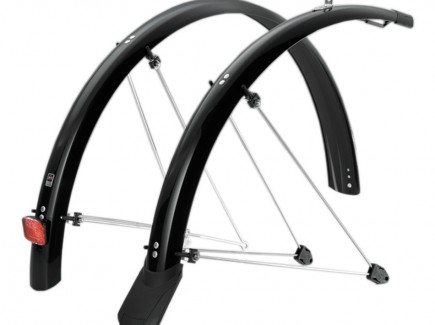
Once you’ve given your bike a good once over you’ll want to make a few additions. First and foremost, mudguards. I cannot emphasise enough the importance of installing a pair of these little wonders. A full length set is best to save you from a soggy and unsightly ‘skunk stripe’ up your backside and from spraying your fellow riders. We’re fans of German brand SKS, who make mudguards for a range of bikes, including kids’ and mountain bikes. For a long time mudguards weren’t compatible with many road bikes, but the game is changing. UK brand Crud now makes a slim ‘n’ sleek set of full length mudguards for road bikes, and if you’re not keen to have a permanent set installed, an easy to store and attach Ass Saver is a thrifty solution to protect your bum in a pinch.
Heavy clouds and sheeting rain can severely affect visibility, and in low light conditions bike riders are legally required to run a white front and red rear light visible to a minimum 200 metres. Given the skies are overcast more often than not in winter, it’s smart to keep your lights ready and charged. If you need a new set, check out the results from the 2015 Ride On lights test.
Be sure to carry a puncture kit, pump and spare tubes. Punctures are more common (and more annoying to fix) in wet weather. You might also consider using Slime instead of air in your tyres. Slime hardens upon contact with the air, blocking the puncture site. It’s a bit heavier, but may save you having to fix a flat in a downpour.
Running clipless pedals will help you maintain good grip. Lubricate them with silicone spray to clip in and out with ease. If you’re running flat pedals, opt for a set with good grip. Personally, I prefer the toothy, metal kind, although they can be rough on delicate shoes.
Finally, if you’re carrying gear on your bike, a waterproof pannier or backpack (or backpack cover) is essential. As an extra precaution, pack your belongings inside a plastic bag.
Gear for you
Once you’ve got your bike sorted, you’ll need a few things to keep the rain off your person. When looking for wet weather gear, opt for bright colours that stand out against the drizzle and reflective details if you’re riding at night. Just be aware that while good lights and high vis gear boost your visibility, they don’t guarantee you’ll be seen. For more on the science of how high visibility fabrics work and how effective they are, see our article ‘Reflecting rides’.
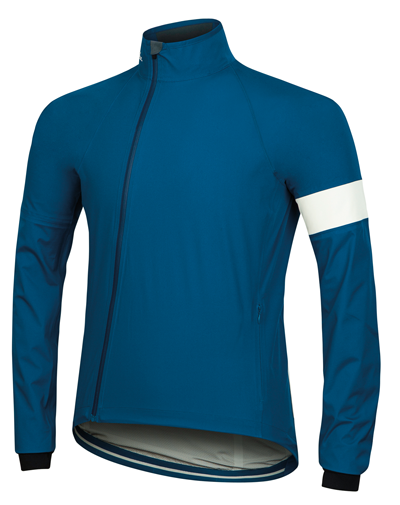
Along with mudguards, a waterproof jacket is a must. The trick is to find a garment that strikes a balance between breathability and protecting you from the rain. Opt for a jacket that’s light and, ideally, seam sealed with zippered vents. If you need suggestions, Ride On has a selection of jacket reviews. If a streamlined ride isn’t a priority, you might prefer a hooded rain cape. These often have the advantage of boasting enough fabric to protect a small backpack or handbag as well as your person. Cycle Style offers a wide selection.
In wet and cold weather it’s important to cover your extremities to avoid numb fingers and soggy socks. Opt for water resistant gloves with good grip to prevent your hands slipping on the handle bars. For your feet, some people recommend waterproof socks, such as SealSkinz, but many find them too warm for Aussie winters (being waterproof, they don’t breathe particularly well). Others swear by wearing plastic bags over their socks, but this can lead to the same problem and, while it’s a cheap solution, it looks rather odd. Waterproof overshoes or ‘booties’ will keep your feet dry and protect your shoes from water damage. 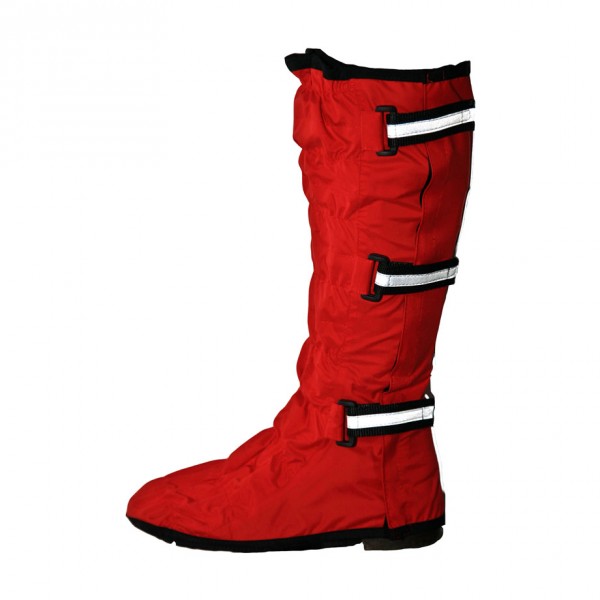 For those who favor winter boots or want a little extra protection from mud splatter, I recommend Leggits from Georgia in Dublin.
For those who favor winter boots or want a little extra protection from mud splatter, I recommend Leggits from Georgia in Dublin.
If you’re going to be doing a lot of wet weather riding, waterproof pants are also a good idea. In the past this meant bulky, unbreathable overpants. These days, however, a number of urban cycling brands offer waterproof and water resistant jeans and pants, such as Outlier’s Daily Riding Pant for women and Vulpine’s Cotton Rain Trousers for men.
Lastly, if you’re running flat pedals, I recommend sturdy shoes with good grip.
Ride smart
Wet weather alters the road environment and it’s important that you ride to the conditions. Storms reduce visibility and leave unexpected detritus, such as broken glass, sticks and burrs, on roads and paths, while puddles can be deeper than expected and obscure pot holes or debris. A wet surface is also harder for tyres to grip. Consequently, braking takes longer and you’re more likely to slip, especially around corners. Check your speed and start braking early, gently feathering the brakes to squeegee water from the wheel rims. Painted and metal surfaces, such as lane markings, grates and
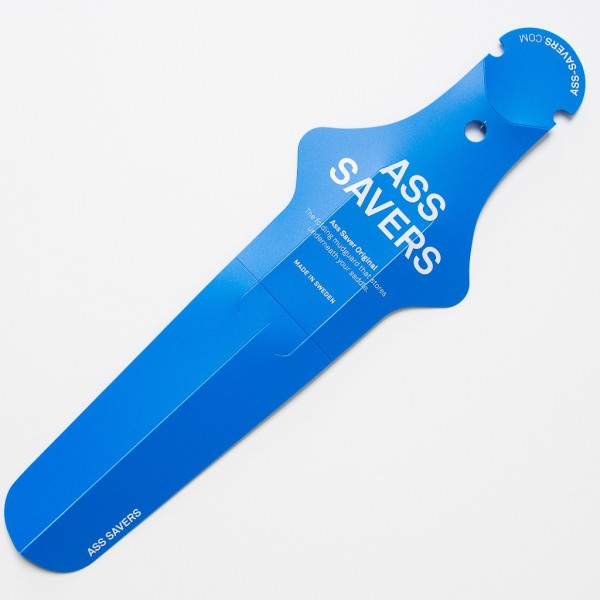
tram tracks, are especially slippery when wet and should be avoided when possible. If you do need to cross one of these surfaces, do so at a minimum 45° and avoid braking. You should also hold your line and resist braking when crossing mud or gravel in the wet.
Wet weather can also bring on a bad case of what I call ‘rain fever’ in some road users—they want to get off the road and out of the wet as quickly as possible and can behave erratically. Ride predictably at a sensible speed, steer clear of blind spots and be extra vigilant of the traffic environment and altered conditions around you.
After your ride
When you arrive at your destination, lock up somewhere secure and out of the weather and find somewhere to hang wet clothes rather than having them sit in a bag all day. If your office doesn’t have a dedicated drying or locker room, see if it’s possible to set up a small clothes rack in the bathroom or somewhere out of the way, i.e. a storeroom. If you arrive at the office with wet shoes, a pair of breathable socks filled with uncooked rice will draw out the moisture.
When you arrive home, check tyres for bits of debris that may have become lodged in the rubber so they don’t surprise you with a puncture on your next ride. If you’ve ridden through a heavy downpour, release any water trapped in your frame by removing the seat post and tipping the bike upside down and giving it a jiggle. It’s not a common problem, but can occur if you spend a lot of time riding in the wet. Some bikes also have drainage holes, typically located in the chain stays.
Last but not least, if it’s been a particularly mucky ride, warm up and reward yourself with a coffee, hot chocolate or tea—you’ve earned it!
Ride On content is editorially independent, but is supported financially by members of Bicycle Network. If you enjoy our articles and want to support the future publication of high-quality content, please consider helping out by becoming a member.

